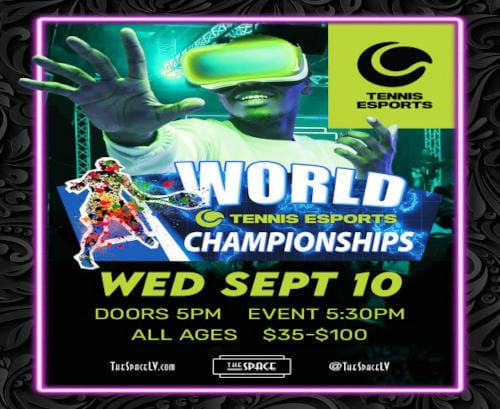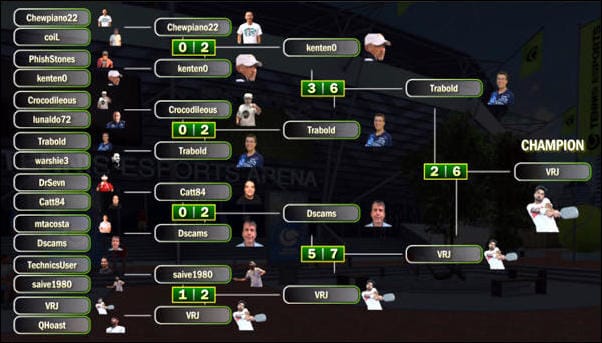- Racket Business
- Posts
- Tennis Esports - Serious Tennis Competition in the VR Space
Tennis Esports - Serious Tennis Competition in the VR Space
World Championships in Las Vegas - Next Level VR Tennis
When Gregory Gettinger, Founder and CEO of VR Motion Learning - Tennis Esports, sent me the invitation to watch the World Tennis Esports Championships in Las Vegas (Press Release), I was a little hesitant. I had bought a Meta Quest 2 headset and the tennis accessory last year, tried it a few times, but wasn’t too excited about Tennis Esports. But then I thought, what the heck, Las Vegas is only an hour flight away from Los Angeles (actually, I flew out of Burbank), hotels are relatively cheap, and I’m curious to see what Gregory is doing there.

Gregory’s venue of choice was The Space. Not as big as The Sphere 😁, but a nice event space for smaller groups. Here’s the floor plan. The Championships were happening on the main stage, where 3 matches could be played at the same time, and also on one side stage.

Gregory Gettinger’s welcome and pics of all players
The 16 finalists were selected from National Leagues and the Tennis Esports Tour. The players came from 7 countries (Switzerland, India, Germany, Austria, Canada, the UK, and the USA). Players and brackets.
The prize pool was $100,000 (cash, tickets, accommodation, coin prizes).

The International Virtual Tennis Federation (IVTF) was listed as the organizer. The IVTF oversees WTEC and is committed to growing Virtual Tennis worldwide. Their mission includes fostering inclusive participation across abilities, genders, and ages, ensuring access, fairness, and integrity in all events, and supporting communities via partnerships with federations, clubs, players, and tech partners.
The video below shows 6 players (3 matches) on the main stage, with the back screen alternating between their matches and the one played on the side stage. On the left is Gregory moderating. The audience was mostly players and their entourage.
Below: View from the back of the audience.
Match format (all singles matches):
Pre-Semis: 10-point tiebreakers.
Semis: 1 set, no ad.
Finals: Best of 3 sets.

The video below shows a match from the side stage and no players on the main stage. You can see how the Avatars move for their players. The players are only hitting and serving while their Avatars do all the running. The speed of an Avatar’s movement is created with an algorithm based on the speed of an average tennis player. Whether or not the Avatar gets a shot and returns it is largely based on the speed, spin, and angle of the shot.
Below: Gregory Gettinger talks about the draw after the semis were played and the two finalists were known.

The image below is the completed draw showing the Champion VRJ from India.

Gregory Gettinger mentioned a few stats and shared more information:
Did You Know this?
1) 10-15% of kids who never touched a racket before and play VR tennis start going onto the real court.
2) Kids improve their tennis skills by 25% to 75% from VR tennis training.
3) Students who play VR tennis become more motivated to play real tennis.
4) Tennis federations are using VR tennis to attract new players and grow the sport’s popularity.
5) VTEC is entering schools across the US, UK, Ireland, Norway, South Korea, Saudi Arabia and other countries.
What is VTEC?
Virtual Tennis Esports Centers VTEC is an innovative online program for schools, designed to teach tennis and esports through engaging VR technology from TENNIS ESPORTS. By merging physical education with immersive digital tools, VTEC empowers schools to introduce tennis in a fun, modern, and cost-effective way. https://tecentres.com/
Why VR Tennis in Schools Matters
Introducing VR tennis into schools is a powerful way to combine sport, technology, and education. Students can learn the fundamentals of tennis without needing full-size courts, expensive gear, or perfect weather. Beyond fitness and coordination, VR tennis encourages inclusivity—every student, regardless of background or location, can participate and develop skills.
At the same time, it boosts digital literacy, blending athletic activity with cutting-edge technology. This makes sports appealing to a digital-first generation while preparing them for a future where physical and digital experiences increasingly overlap. By engaging kids early, VR tennis not only promotes healthier lifestyles and sparks interest in tennis but also ensures the sport stays relevant and inspiring for the next generation.
My Summary
I was impressed by the organization, how Gregory handled the show, and how seriously the players take their matches. The average age of the players was a little older than I expected, probably around 40-45. Most or all of the participants were tennis players, and some were teaching pros.
I was also impressed with the venue. The Space was the perfect size for the event. It was pretty close to the hotel I was staying at, the Rio Hotel & Casino.
I used to question whether there was a future for Tennis Esports or if it’s all just a gimmick. Not anymore. I do think the sport has a future, and we will see a lot of it in the coming years. The applications are both in having a fun home tennis outlet and in using Tennis Esports as a serious training tool. New leagues will be forming, and many more championships will follow.
There will be improvements, of course, especially when it comes to the Avatars, their movement, and how they interface with the players.
Tennis purists will probably not rush to the store and buy VR Headsets anytime soon. I can see that. But there are also developments to improve the gear, make it lighter, and program it to do much more than gaming.
I think the future is bright for Tennis Esports.

